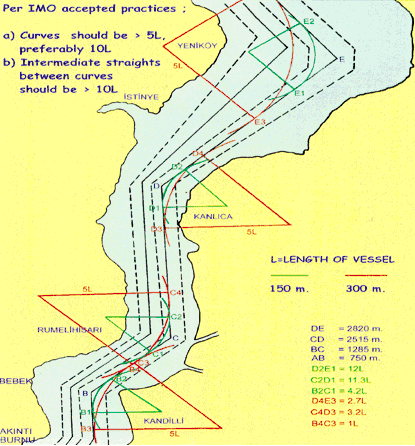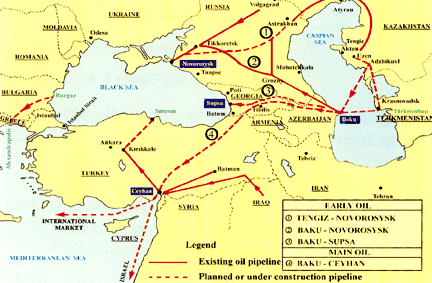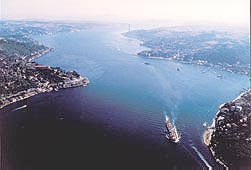|

Winter
1998 (6.4)
Pages 86-87
Pipeline to
Jeyhan:
The Turkish
Perspective
by Nihat
Gokyigit
Left: Photo showing the narrow straits of
the Bosphorus.
Right: Turkey fears oil tanker collisions
like the one that occurred in the Bosphorus in 1994.
For
landlocked Azerbaijan, finding oil and pumping it out of the
ground is only part of the struggle. An important question is
still undecided: how will Azerbaijan transport its "major
oil" to the world market? Which route will it take? Various
proposals for main export pipeline routes have been put forward,
but no single one has been finalized.
One route goes
by land from Baku to Supsa, Georgia. At Supsa, the oil is transferred
by ship across the Black Sea and through Turkey's Bosphorus Straits
before reaching the Mediterranean. Another route goes by land
from Baku to Novorossiysk, Russia, where the oil then takes a
path similar to the Supsa route: over the Black Sea and through
the Bosphorus Straits.
Turkey has repeatedly argued that these two options are problematic
because the ship traffic going through the Bosphorus is already
too congested. Any more ships in the waterway could create an
environmental disaster.
One possible land route would travel from Baku through Georgia
and Turkey to Jeyhan (Turkish spelling, "Ceyhan"),
a Turkish port on the Mediterranean. Potentially, the pipeline
could also be used to connect Kazakhstan and Turkmenistan's oil
to the world market using Azerbaijan as a "transit country,"
perhaps via a pipeline to Baku across the bottom of the Caspian
Sea.
Turkey is pushing for Azerbaijan to follow this latter route,
called the Baku-Jeyhan route. Here Nihat Gokyigit, co-chairman
of the Istanbul-based company Tekfen, examines these issues from
the Turkish point-of-view.
  Diversification Diversification
As a
newly independent nation, Azerbaijan must not allow its economy
to become dependent on any one nation. In this context, the path
that Azerbaijan chooses for exporting its oil is crucial.
Left: Map shows the treacherous
turns that oil tankers (the size of three football fields) must
navigate in the Bosphorus.
In order for the Caspian to be considered on its own as one of
the world's main oil regions, it must not rely too heavily on
Russia or Iran. Diversification is key. Likewise, the West is
anxious to diversify its energy sources; countries like the U.S.
don't want to rely completely on the Persian Gulf for their oil
supply.
For many of
the proposed pipeline routes, Azerbaijan would have to depend
on either Russia or Iran, potential competitors who have their
own oil to sell. Using the Novorossiysk route, for example, would
increase Russia's influence in the region. Directing the oil
through Iran would be frowned upon by nations such as the U.S.,
which still views Iran as a terrorist state. A Baku-Jeyhan route
would mean that Azerbaijan would not have to rely on either of
these two countries.
Turkey is an independent outlet, and Azerbaijan's ally. It also
has the potential to be one of Azerbaijan's biggest customers.
Turkey has one of the largest fuel deficits in the region, as
it only produces 15% of its own needs. The country consumes approximately
30 million tons of oil each year, providing a strong demand for
Azerbaijan's oil.
Map showing
the various pipeline route options from Azerbaijan and Central
Asia.
  Environmental Risks Environmental Risks
Using
either the Supsa or the Novorossiysk pipeline would mean transporting
oil across the Black Sea. One problem with this process is that
the sea is already very polluted.
Rough waves and bad weather make it difficult for ships to cross
the sea safely. Oil would have to be loaded on and off of ships,
increasing the chance of a spill and even more damage to the
environment. Numerous non-governmental organizations have already
organized against the pollution in the Black Sea, and it is highly
probable that increased oil traffic would spur on even more protests.
Any oil transported via the Black Sea must pass through Turkey's
Bosphorus Straits before it can reach the Mediterranean. The
Bosphorus is an 18-mile-long international waterway that divides
the city of Istanbul (pop. 12 million). At its narrowest point,
the Bosphorus is 2,450 feet (750m) wide. The journey through
it is a treacherous one-bad weather, fog and unpredictable currents
increase the danger.
Ships have to change course at least 12 times to navigate the
narrow, winding waterway. Sending tankers the length of three
football fields through this passage is equivalent to inviting
an accident to happen. (In fact, 150 serious accidents have already
happened.)
The 1936 Montreux Convention guaranteed free passage through
the Straits to any ship, day or night. But at the time, four
to five ships passed through the Straits each day. Today the
number is closer to 150, many of which are oil tankers. That's
three times as much traffic as in the Suez Canal. Turkey is very
worried about the environmental threat that this congested traffic
poses, and believes that the framers of the Montreux accord did
not foresee the danger of the chemical, explosive and nuclear
cargoes now being carried through the Bosphorus.
Close to the water lie important historical landmarks such as
the Topkapi Palace (built in the 1460s), the Hagia Sophia Mosque
(also spelled "Ayasofya" or "Ayia Sofia")
(537 AD), and the Dolmabahche Palace and Mosque (1853). Every
tanker that passes through the Bosphorus endangers lives and
cultural landmarks. Additional tanker traffic from Caspian oil
would significantly increase that risk.
The Cost Factor
Many different estimates for the Baku-Jeyhan pipeline have been
tossed around, putting the cost at anywhere between $1.8 and
$4.5 billion. Oil consortium Azerbaijan International Operating
Company (AIOC) recently upped their estimate from $2.5 to approximately
$4 billion. Turkey estimates that the pipeline is more likely
to cost around $2.3 to $2.4 billion and is willing to help subsidize
the construction. Estimates for the Georgian and Russian pipelines
are generally lower, but don't fully allow for other potential
costs, including costs to the environment. For example, a tremendous
loss would occur if there were to be a major accident and oil
spill in the Bosphorus Straits. What would it cost to clean up
the polluted environment? What would it cost to buy insurance
to cover such a catastrophe?
Closure of the Straits due to an accident would block all traffic
and choke the Black Sea states. What about the time a ship would
spend waiting for the Straits to reopen? These costs must be
considered in the estimate of any oil route that passes through
the Bosphorus. A pipeline on the Baku-Jeyhan route may seem to
be more expensive, but it is an investment that will save money
(and the environment) in the long run.
Today's Myths
The
major arguments by opponents of the Baku-Jeyhan pipeline are
as follows:
Myth
#1:
The Bosphorus Straits can handle the additional traffic from
Caspian oil.
Truth: There is not room for additional oil from the Caspian
to pass through the Straits. Turkey recently passed safety regulations
to slow down the traffic from cargo vessels, which increases
by 15 to 20 percent each year. Additional tankers coming through
with Caspian oil would spell disaster.
Myth
#2:
There's not enough oil in the Caspian to justify building the
Baku-Jeyhan pipeline.
Truth: The oil reserves of the Caspian are estimated to be the
world's second-largest, after Saudia Arabia. The 15 to 70 billion
tons of reserves are believed to exceed those of Alaska and the
North Sea. Accordingly, companies from 40 different nations are
active in the Caspian Basin and are anxious to exploit its tremendous
resources. In Azerbaijan alone, 16 production sharing agreements
have been signed. Annual investments are expected to reach $2
billion a year by the year 2001, reaching a total of $47 billion.
There is plenty of oil in the Caspian. With this in mind, the
proposed Baku-Supsa pipeline is a temporary solution, as it would
only be able to transport half as much oil as the proposed Baku-Jeyhan
pipeline.
Myth #3:
Lower oil prices mean that the Baku-Jeyhan pipeline is no longer
cost-effective.
Truth: Lower oil prices do put pressure on companies to minimize
the cost of transporting oil. Even though prices for oil are
at their lowest in more than a decade, interest in delivering
Caspian oil to the West is still strong. If we use a reasonable
estimate for the Baku-Jeyhan line, we see that this option is
still competitive with other routes.
Myth #4: AIOC has to support
the Baku-Jeyhan pipeline in order for it to be built. AIOC, a
consortium of 11 companies led by British Petroleum-Amoco (a
new merger) has yet to take a firm position one way or another
on the pipeline issue. They want to keep their options open as
long as possible. Lately, AIOC seems to be leaning toward the
proposed pipeline to Supsa. Due to historically low oil prices
and low production volumes from the Caspian area at present,
AIOC is skeptical about the Jeyhan pipeline and fears that it
may not be commercially viable.
Truth: AIOC is not the only decision-maker in this process, however.
Other oil companies and consortia have large fields as well.
They may very well decide to move forward with the Baku-Jeyhan
pipeline with or without AIOC. For instance, Royal Dutch/Shell,
Mobil, Chevron and the government of Kazakhstan recently agreed
to undertake a study of the feasibility of an oil pipeline from
Kazakhstan that would pass through the Caspian Sea to Baku, then
overland to Jeyhan. Meanwhile, AIOC has decided to delay its
final decision on the pipeline until at least early February.
Widespread Support
Heads
of state in the Caspian region agree that the Baku-Jeyhan pipeline
is the best choice for reaching the world market. On October
29, 1998, the leaders of Turkey, Azerbaijan, Georgia, Uzbekistan
and Kazakhstan met in Ankara and signed an agreement to support
the Baku-Jeyhan pipeline. The U.S. Secretary of Energy, Bill
Richardson, signed the declaration as an observer. These leaders
understand that a Baku-Jeyhan pipeline would benefit the entire
Caspian region.
The U.S. has also voiced a strong preference for the Baku-Jeyhan
pipeline route. It favors this route because much of the pipeline
would go through Turkey, the country's only NATO ally in the
region. To keep Russia and Iran from participating in a main
export pipeline, the U.S. has urged the Caspian states to adopt
an "east-west corridor" for oil; the Baku-Jeyhan pipeline
is by far the most feasible option that Azerbaijan can take.
This article
was based on a presentation given by Nihat Gokyigit at the Eurasian
Transport Corridor conference in Washington, D.C. on November
18, 1998. Mr. Gokyigit is a Co-Chair of the Tekfen Company and
a Board Member of Deik.
From
Azerbaijan
International
(6.4) Winter 1998.
© Azerbaijan International 1998. All rights reserved.
Back to Index AI 6.4 (Winter
1998)
AI Home
| Magazine
Choice | Topics
| Store
| Contact
us
|




